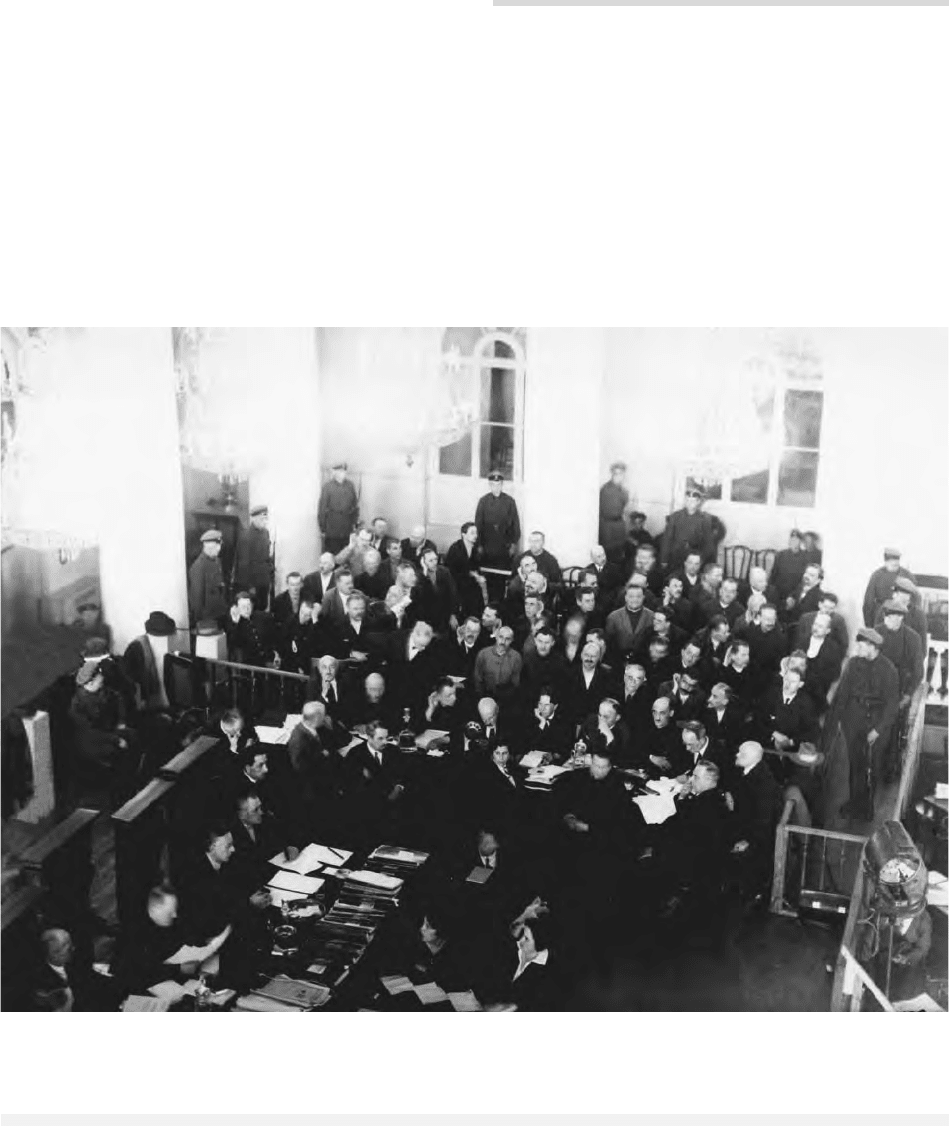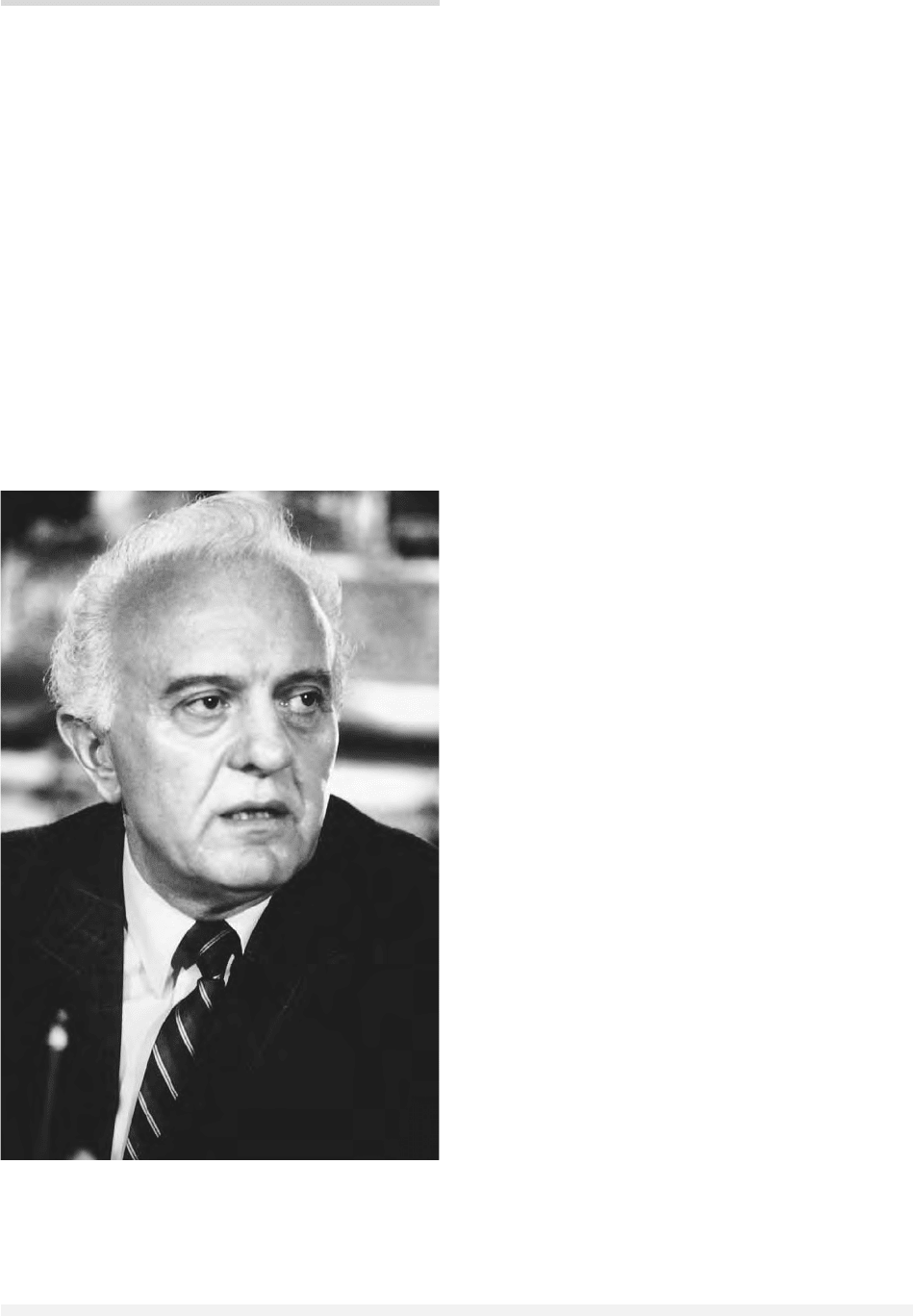Encyclopedia of Russian History
Подождите немного. Документ загружается.


The October Revolution abolished Christianity
and the Agapetos formula as the regime’s ideology.
The Bolsheviks replaced it with Marxist-Leninist di-
alectical historical materialism. Stalin, sensing a
threat from the United Kingdom in 1927, used the
new ideology to legitimize his launching of the
third service class revolution in 1928.
The Soviet service state proved unable to man-
age the economy efficiently, but the service class
remained during the Leonid Brezhnev (1964–1982),
Yuri Andropov (1982–1984), and Konstantin Cher-
nenko (1984–1985) years. The Soviet service class
had already begun to generate into a privileged elite
(what Milovan Djilas termed “the new class”) by
the end of the 1930s, and this degeneration had
turned into a rout by 1985. By the middle of the
1970s “the working class pretended to work and
the state pretended to pay them.” The general trend
was for people to go to work to socialize with their
friends, not to produce anything. By the time of
the coup of August 19, 1991, attempting to over-
throw Mikhail Gorbachev, the privileged elite (the
“nomenklatura”) rode around in their own private
motorcars and went straight to the head of long
lines for ordinary consumer goods such as news-
papers and magazines while getting most of their
goods from closed stores open only to the privileged
elite. It was obvious that the Soviet service state
was no longer working, could not make the econ-
omy grow or improve the lives of its subjects, and
was little more than a debauchery of corruption.
Gorbachev, another believer in socialism, tried to
reform the system, but it proved impossible. The
service state lost its teeth when he repealed Article
6 of the Brezhnev constitution, which had given the
Communist Party a monopoly on Soviet political
life. The Communist Party had also assumed a mo-
nopoly on all elite positions, so that one had to be
a member of the CPSU to hold many jobs. That had
not been true during the times of Stalin and Nikita
Khrushchev. This change was another sign of the
degeneration of the service state under Brezhnev.
When Gorbachev delivered the coup de grace to
the Soviet service state, no one wept. The service
state was a major Russian “contribution” to the
human experience. Whether there ever will be a
fourth service class revolution remains to be seen.
See also: ECONOMIC GROWTH, SOVIET; ECONOMY,
TSARIST; INDUSTRIALIZATION; MILITARY, IMPERIAL
ERA; MILITARY, SOVIET AND POST-SOVIET; RUSSIAN
ORTHODOX CHURCH; SERFDOM
BIBLIOGRAPHY
Hellie, Richard. (1971). Enserfment and Military Change in
Muscovy. Chicago: University of Chicago Press.
Hellie, Richard. (1987). “What Happened? How Did He
Get Away with It? Ivan Groznyi’s Paranoia and the
Problem of Institutional Restraints.” Russian History
14:199–224.
Hellie, Richard. (2002). “The Role of the State in Seven-
teenth-Century Muscovy.” In Modernizing Muscovy,
ed. J. T. Kotilaine and Marshall T. Poe. Leiden: Brill.
Kliuchevskii, V. O. (1960). A History of Russia. 5 vols.,
tr. C. J. Hogarth. New York: Russell & Russell.
Swianiewicz, Stanislaw. (1965). Forced Labor and Economic
Development: An Enquiry into the Experience of Soviet
Industrialization. London: Oxford University Press.
Tucker, Robert C. (1990). Stalin in Power: The Revolution
from Above, 1928–1941. New York: Norton.
Voslensky, Michael. (1984). Nomenklatura: The Soviet
Ruling Class, tr. Eric Mosbacher. Garden City, NY:
Doubleday.
R
ICHARD
H
ELLIE
SEVASTOPOL
City and naval base on the southwestern tip of the
Crimean Peninsula in Ukraine.
With its excellent harbors and anchorages, Sev-
astopol has an advantageous location from which
to conduct operations in the Black Sea. The city
stands on the southern shore of Sevastopol Bay and
has a population of 390,000—75 percent Russian
and 20 percent Ukrainian. The site of ancient set-
tlements, modern Sevastopol was founded by
Prince Grigory Potemkin in 1783 after the conquest
of the Crimean Khanate. Admiral F.F. Mekenzy,
commander of the newly created Black Sea Fleet,
placed a naval station there, and in 1784 the set-
tlement was named Sevastopol.
In 1804 Alexander I’s government declared Sev-
astopol the primary naval base of the Black Sea
Fleet. The naval base and the city grew significantly
during the second quarter of the nineteenth cen-
tury when Admiral Mikhail Lazarev served as fleet
commander. By 1844 the city had a population of
more than forty thousand, making it the largest
city in Crimea. Sevastopol became the major base
for fitting out and repairing warships. Its defenses
grew in extent and quality.
In 1853 Admiral Pavel Nakhimov’s squadron
sailed from there to Sinope, where it annihilated a
SEVASTOPOL
1373
ENCYCLOPEDIA OF RUSSIAN HISTORY

Turkish squadron. During the Crimean War, An-
glo-French forces besieged Sevastopol. The defense
was immortalized by Leo Tolstoy, one of the de-
fenders, in his Sevastopol Tales. Sevastopol fell to
the Anglo-French forces in September 1855.
Following the Crimean War, Sevastopol suf-
fered decline, because the peace treaty denied Rus-
sia the right to maintain a fleet in the Black Sea.
With the remilitarization of the Black Sea after
1870 Sevastopol regained its importance as a naval
base for a modern ironclad fleet.
Sevastopol was associated with rebellion, mu-
tiny, and civil war. In 1830 government restric-
tions to combat a cholera epidemic set off a revolt
among sailors and civilians. In June 1905 the bat-
tleship Potemkin sailed from Sevastopol on its way
to mutiny over bad meat. During the Russian civil
war Sevastopol was the headquarters of Baron Pe-
ter Wrangel’s White Army. The Red Army under
Mikhail Frunze stormed Crimea in October 1920,
and Wrangel evacuated his army to Istanbul.
During World War II Sevastopol was the site
of an eight-month siege by German and Ruman-
ian forces under Field Marshal Erich von Manstein
and fell in July 1942. On May 9, 1944, the Soviet
Fourth Ukrainian Front under the command of
Marshal Fyodor Tolbukhin liberated the city.
Following the end of the existence of the Soviet
Union in 1991, Russia and Ukraine entered into
negotiations over Sevastopol. During the early
twenty-first century the city is a special region
within Ukraine, not under the government of
Crimea, and the Russian and Ukrainian navies
share the naval base.
See also: BLACK SEA FLEET; CRIMEA; CRIMEAN WAR;
UKRAINE AND UKRAINIANS; WHITE ARMY
BIBLIOGRAPHY
Curtiss, John Shelton. (1979). Russia’s Crimean War.
Durham, NC: Duke University Press.
Tolstoy, Leo. (1961). Sebastopol. Ann Arbor: University
of Michigan Press.
J
ACOB
W. K
IPP
SEVEN-YEAR PLAN
Following the rise of Nikita Khrushchev to primacy
among the leaders of the Soviet Union, the sixth
five-year plan (1956–1960) was abandoned as in-
feasible, leaving the country without a perspective
plan for the first time in three decades. In one of
his many reorganizations, Khrushchev substituted
a Seven-Year Plan to run from 1959 to 1965. It in-
cluded his new priorities for a much larger chem-
ical industry, more housing, substitution of oil and
gas for coal in the production of electricity and for
powering the railroads, and more emphasis on
agriculture, especially in the eastern areas.
Planned targets for 1965 were ambitious, and
some were even raised in October 1961. Despite
considerable growth of housing construction, meat
production, and consumer durables, fulfillment
was not achieved in many areas. Khrushchev had
grand hopes for the chemical industry and agri-
culture, but the targets for mineral fertilizers, syn-
thetic fibers, and the grain harvest were all missed.
Civilian investment rates fell, and national income
(defined in Marxist concepts) was underfulfilled by
four to seven percent. Gross production volume of
producers goods did exceed the long-term plan,
with an index (1959⫽100) of 196 achieved versus
185–188 planned, while consumer goods fell be-
low it, 160 actual versus 162–165 planned.
The shortfalls can perhaps be explained by the
strain of increased expenditures on space and mil-
itary ventures in these years and the complexity of
planning for more tasks. The continual sovnarkhoz
(regional economic council) reorganizations, which
put considerable strain on Gosplan to coordinate
supplies, probably also had a negative impact on
overall results.
See also: FIVE-YEAR PLANS; GOSPLAN
BIBLIOGRAPHY
Nove, Alec. (1969). An Economic History of the U.S.S.R.
London: Allen Lane.
M
ARTIN
C. S
PECHLER
SEVEN YEARS’ WAR
The Seven Years’ War (1756–1763) involved nearly
every European state and was watershed in world
history. It arose as a result of the Anglo-French
colonial rivalry and because of the growing might
of Prussia in central Europe, which threatened the
interests of Austria, France, and Russia. The out-
SEVEN-YEAR PLAN
1374
ENCYCLOPEDIA OF RUSSIAN HISTORY

come ensured that England became the dominant
power in North America, and the war consolidated
the growing power and prestige of Frederick the
Great’s Prussia. For this, he could thank Russia and
its bizarre participation in the war. Internally, Russ-
ian actions in the Seven Years’ War also brought
about a palace coup and the subsequent rule of
Catherine II.
Prussia had emerged as a potential European
power by the middle of the eighteenth century. Un-
der Frederick II (r. 1740–1786), Prussian policies
became increasingly ambitious. Frederick wanted to
consolidate his power and territories gained at the
expense of Austria during the 1840s. Austria, for
its part, desired a return of territories such as Sile-
sia. Russia and France also worried over Prussian
power and potential incursions near their respec-
tive borders. When war broke out between France
and England over their North American territories,
Prussia signed an alliance with England in January
1756. The alliance brought a rapprochement be-
tween France and Austria. By the end of 1756, Rus-
sia signed a new alliance with its traditional ally,
Austria. The sides had been drawn.
After war broke out in 1756 on the continent,
Frederick’s forces enjoyed success against the Aus-
trians. By April 1756 the Prussians reached Prague.
In the Bohemian capital the Austrians rallied, and
Frederick’s forces retreated. At that point Austria’s
allies, including Russia, entered the conflict. Despite
the numbers stacked against him, Frederick con-
tinued to win surprising victories, and 1757 es-
tablished his reputation as a brilliant commander.
The following year brought mixed results and
mounting casualties for the Russians, who lost
twelve thousand troops at August’s Battle of Zorn-
dorf. In 1759 the allies, and particularly Russia,
ratcheted up the pressure. Led by General Pyotr
Saltykov, the Russian army occupied Frankfurt in
June 1759. By 1760 Frederick had only half the
numbers of his Russian and Austrian opponents,
who began to close the circle against Frederick.
Russian commanders in particular focused on
Berlin, and even occupied the Prussian capital for
three days in September and October 1760. Ex-
hausted by the continuous marching demanded of
eighteenth-century warfare, the two sides fought
no serious battles for the rest of 1760 and most of
1761. Frederick’s situation, however, was grave.
Russia and Austria could count on more soldiers
and supplies, and Prussia was cut off from Silesia,
a major supplier of food.
Then the situation changed dramatically. On
January 5, 1762, the Empress Elizabeth died. Her
successor, Peter III, was a fervent admirer of Freder-
ick II and all things Prussian. When he took the
throne, Peter ended the war with Prussia, called his
troops back, and returned all territorial gains. As a
result, Frederick recovered and defeated the Austri-
ans. France, defeated in North America and more dis-
interested about the continental war, also signed a
treaty with Prussia. Frederick’s “miracle” had resulted
from Russia’s flip-flop, and his victory brought the
first step toward Prussian domination of Germany.
At home, Peter III’s decision ran counter to Rus-
sia’s strategic and political interests. Contempo-
raries called the conflict the “Prussian War,” and
even popular prints of the time depicted the war as
a struggle solely between Russia and Prussia. The
decision to hand Frederick victory thus did not go
over well within any segment of the population.
Catherine, Peter’s German wife, led a palace coup
against her husband that toppled him from power
on July 9, 1762. Catherine II’s rise to power would
have been inconceivable had it not been for Russia’s
participation in the war.
See also: AUSTRIA, RELATIONS WITH; CATHERINE II; ELIZ-
ABETH; FRANCE, RELATIONS WITH; PETER III; PRUSSIA,
RELATIONS WITH
BIBLIOGRAPHY
Anderson, Fred. (2001). Crucible of Empire: The Seven Years’
War and the Fate of Empire in British North America,
1754–1766. New York: Vintage.
Keep, John L. H. (2002). “The Russian Army in the Seven
Years’ War.” In The Military and Society in Russia,
1450–1917, ed. Eric Lohr and Marshall Poe. Leiden:
Brill.
Leonard, Carol. (1993). Reform and Regicide: The Reign of Pe-
ter III of Russia. Bloomington: Indiana University Press.
S
TEPHEN
M. N
ORRIS
SHAHUMIAN, STEPAN GEORGIEVICH
(1878–1918), Bolshevik party activist and theorist
on the nationality question; principal leader of the
Bolsheviks in Baku during the Russian Revolution
who perished as one of the famous Twenty-Six
Baku Commissars.
Born into an Armenian family in Tiflis (Tbil-
isi), the young Shahumian was educated in local
SHAHUMIAN, STEPAN GEORGIEVICH
1375
ENCYCLOPEDIA OF RUSSIAN HISTORY

schools before entering the Riga Polytechnic Insti-
tute in 1900. Active in Armenian student political
circles, he turned toward Marxism in Riga. Expelled
for his political activities, Shahumian continued his
studies at the University of Berlin, where he joined
the Russian Social Democratic Workers’ Party (RS-
DRP). He grew close to Vladimir Lenin and the Bol-
sheviks, translated the Communist Manifesto into
Armenian, and was elected a delegate to the Fourth
(Stockholm) and Fifth (London) Congresses of the
RSDRP. Shahumian was active in the strike move-
ment in Baku during the first Russian revolution
(1905–1907) and throughout the years of reaction
and repression of the labor movement, and was ar-
rested and imprisoned several times. When the Feb-
ruary Revolution broke out, he returned from exile
in Astrakhan and assumed leadership of the Baku
Bolsheviks.
Elected chairman of the Baku Soviet of Work-
ers’ and Soldiers’ Deputies, Shahumian was the
most important figure in Baku politics in 1917 and
1918. After the October Revolution, Lenin’s gov-
ernment appointed him Extraordinary Commissar
for the Affairs of the Caucasus. Shahumian headed
the Council of People’s Commissars, the de facto
government of the Baku Commune, from April
through July 1918. Although he was moderate in
temperament and tolerant of diverse political par-
ties, his brief tenure was marked by a brash at-
tempt to expand Soviet power throughout the
Caucasus by military means. As the Turkish army
approached Baku, the soviet voted to invite Persia-
based British forces to defend the city. Shahumian’s
government stepped down and soon was arrested.
On September 20, 1918, anti-Bolsheviks brutally
executed twenty-six commissars, among them
Shahumian, in the deserts of Transcaspia (now
Turkmenistan). The Soviet government blamed the
British for their deaths and commemorated them
as martyrs to the revolution. Reburied in a mass
grave in Baku, they became the inspiration for
paintings, songs, poems, and films. But with the
fall of the Soviet Union, anticommunist Azerbai-
janis disinterred their corpses and destroyed their
monuments.
See also: ARMENIA AND ARMENIANS; BAKU; BOLSHEVISM;
CAUCASUS; SOCIAL DEMOCRATIC WORKERS PARTY
BIBLIOGRAPHY
Suny, Ronald Grigor. (1972). The Baku Commune,
1917–1918: Class and Nationality in the Russian Rev-
olution. Princeton, NJ: Princeton University Press.
R
ONALD
G
RIGOR
S
UNY
SHAKHRAI, SERGEI MIKHAILOVICH
(b. 1956), lawyer and former minister of nation-
alities.
Sergei Shakhrai trained as a lawyer at Rostov
State University and attained the rank of candidate
of juridical sciences from Moscow State University
(MGU) in 1982. He then taught law at MGU un-
til 1990. Shakhrai was a Party member from 1988
to August 1991.
In 1990, Shakhrai was elected to the new
RSFSR Congress of People’s Deputies, where he
quickly became chair of the RSFSR Supreme Soviet
Committee for Legislation. He simultaneously
served Boris Yeltsin as a counselor for legal and na-
tionalities affairs. In 1992 he was named a mem-
ber of the Russian Federation Security Council and
deputy chair responsible for nationality issues.
During the November–December 1992 ethnic un-
rest in North Ossetia and Ingushetia, Shakhrai
served as head of the temporary regional adminis-
tration. A Terek Cossack, he also chaired the Rus-
sian parliamentary committee on the rehabilitation
of the Cossacks. In November 1992, Shakhrai was
appointed a deputy prime minister.
In legal matters, Shakhrai argued Yeltsin’s case
in the 1992 Constitutional Court hearings on the
legality of the president’s banning of the CPSU, a
decree written by Shakhrai himself. He also served
as Yeltsin’s representative to the 1993 Duma com-
mission drafting a new Russian constitution and
negotiated many of the subsequent federal power-
sharing treaties. Shakhrai became leader of the
Party of Russian Unity and Accord in October
1993, running on their ticket in the December 1993
Duma election. However, he resigned from the
party when the party joined the Our Home is Rus-
sia movement in August 1995.
Shakhrai was transferred from deputy prime
minister to minister of nationalities and regional
policy in January 1994. This move was soon over-
turned; by April he was reappointed deputy prime
minister and in May removed as minister of na-
tionalities. However, he continued to influence the
decisions of his replacement, Nikolai Yegorov.
Shakhrai’s work in law and nationality affairs
combined in the issue of Chechnya. Despite Chechen
president Dzhokar Dudayev’s assertions otherwise,
Shakhrai insisted that Chechnya remained an inte-
gral part of the Russian Federation. When Dudayev
refused to ratify the new constitution, despite
Shakhrai’s repeated attempts at negotiation, he
SHAKHRAI, SERGEI MIKHAILOVICH
1376
ENCYCLOPEDIA OF RUSSIAN HISTORY

provided the legal pretext for an invasion. Shakhrai
and minister of defense Pavel Grachev convinced
Yeltsin that an attack on Chechnya would be quick
and painless; ultimately, the attack was launched
in December 1994. Shakhrai’s prediction proved
false, however, as the first Russo-Chechen war
lasted until August 1996.
Yeltsin summarily fired Shakhrai in June 1998,
when the lawyer questioned the constitutionality
of a possible third term as president for Yeltsin.
However, Shakhrai was not unemployed for long.
In October, prime minister Yevgeny Primakov ap-
pointed Shakhrai as his own legal advisor. Shakhrai
also won a Duma seat for Perm oblast during the
1999 election. As of 2003 he was a member of the
influential Russian Foreign and Defense Policy
Council and was teaching at Moscow State Insti-
tute for International Relations (MGIMO).
See also: AUGUST 1991 PUTSCH; PARTY OF RUSSIAN UNITY
AND ACCORD
BIBLIOGRAPHY
Dunlop, John B. (1998). Russia Confronts Chechnya: Roots
of a Separatist Conflict. New York: Cambridge Uni-
versity Press.
Lieven, Anatol. (1998). Chechnya: Tombstone of Russian
Power. New Haven: Yale University Press.
A
NN
E. R
OBERTSON
SHAKHTY TRIAL
This famous trial based on fabricated charges was
used by Stalin to start a three-year attack on the
technical intelligentsia of the USSR and to discredit
moderates within the political leadership. Fifty-
three mining engineers and technicians, including
some top officials and three German engineers,
were accused of acts of sabotage and treason dat-
ing back to the 1920s and taking part in a con-
spiracy directed from abroad (involving French
SHAKHTY TRIAL
1377
ENCYCLOPEDIA OF RUSSIAN HISTORY
Courtroom scene from the Shakhty sabotage trial in 1928. © TASS/SOVFOTO

finance and Polish counterespionage). The story of
conspiracy was fabricated by the Unified State
Political Administration (OGPU) officials in the
North Caucasus mining district known as the
Donbass and focused on such acts as wasting cap-
ital, lowering the quality of production, raising its
costs, mistreating workers, and other forms of
“wrecking.”
Held in a large auditorium at the House of
Trade-Unions in Moscow, this six-week-long trial
was arranged for maximum publicity, with movie
cameras, a hundred journalists in attendance, and
a different public audience each day. The presiding
judge over the specially organized judicial presence
was Andrei Vyshinsky, famous for his appearance
as prosecutor at the major show trials of the 1930s;
the prosecutor at the Shakhty trial was the Bol-
shevik jurist Nikolai Krylenko. For evidence, the
prosecution relied on confessions of the accused,
but twenty-three of the defendants proclaimed their
innocence, and a few others retracted their confes-
sions at trial. As a political show trial Shakhty was
imperfect. Still, all but four of the accused were
convicted, and five of them executed.
In the wake of the Shakhty trial, non-Marxist
engineers and technicians were placed on the de-
fensive and many fell victim to persecution. “Spe-
cialist baiting” ranged from verbal harassment to
firing from jobs, not to speak of arrests and con-
victions in later trials, including the well-known
“Industrial Party” case. By 1931, when Stalin called
a halt to the anti-specialist campaign, Soviet engi-
neers had been tamed and any nascent threat of
technocracy defeated.
On the political level, the Shakhty trial served
Stalin as a vehicle for radicalizing economic policy
and sending a message of warning to moderates in
the leadership (such as Alexei Rykov and Nikolai
Bukharin). If nothing else, the persecution of the
“bourgeois specialists” weakened one of the con-
stituencies that supported a relatively cautious and
moderate approach to industrialization. With hind-
sight it is clear that the Shakhty trial, along with
the renewal of forced grain procurements, signaled
the coming end of the class-conciliatory New Eco-
nomic Policy and the start of a new period of class
war that would culminate in the forced collec-
tivization from 1929 to 1933. An important man-
ifestation of the new class war was the Cultural
Revolution from 1928 to 1931, in which young
communists in many fields of art, science, and pro-
fessional life were encouraged to attack and sup-
plant their non-Marxist senior colleagues.
See also: SHOW TRIALS; STALIN, JOSEF VISSARIONOVICH
BIBLIOGRAPHY
Bailes, Kendall. (1978). Technology and Society under Lenin
and Stalin: Origins of the Soviet Technical Intelligentsia,
1917–1941. Princeton, NJ: Princeton University
Press.
Fitzpatrick, Sheila. (1978). “Cultural Revolution as Class
War.” In Cultural Revolution in Russia, 1928–1931,
ed. Sheila Fitzpatrick. Bloomington: Indiana Univer-
sity Press.
Kuromiya, Hiroaki. (1997). “The Shakhty Affair.” South
East European Monitor 4(2):41–64.
P
ETER
H. S
OLOMON
J
R
.
SHAMIL
(1797–1871), the most famous and successful anti-
Russian Islamic resistance leader during the nine-
teenth century; lionized by Chechen and Dagestani
nationalists and co-opted by Russian literature and
the public consciousness as a sign of tsarist impe-
rial expansion and the Russian mission in Asia.
Born in Gimri, modern Dagestan, Shamil demon-
strated an early skill with weapons and horses. He
entered a madrassah where he learned grammar,
logic, rhetoric, and Arabic. There he joined the
Murids, of the Naqshbandi-Khalidi Sufi order, in
1830. Following the transfer of Dagestan from Per-
sia to the Russian Empire, Murids initiated a jihad
against Russia under the leadership of Shamil’s men-
tor, the first imam of Dagestan, Ghazi Muhammed.
After his death and the brief leadership of Hamza
Bek, Shamil became the third imam of Dagestan and
declared it an independent state in 1834. His personal
charisma, political acumen, state building, and mil-
itary ability as well as his blending of an egalitarian
interpretation of Shari’a (Islamic Law) with procla-
mations of jihad against the Russian advance made
him a popular political and religious leader (even
among the non-Muslims of the North Caucasus).
For twenty-five years (1834–1859), Shamil led
raids on Russian positions in the Caucasus. He
reached the peak of prestige in 1845 devastating
the advance of Mikhail Vorontsov, who organized
an army to complete the final conquest of the Cau-
casus. In these years of struggle, Shamil unified the
disparate communities of the North Caucasus, built
a state, organized a regular army, and completed
the Islamicization of Dagestan and Chechnya. In
SHAMIL
1378
ENCYCLOPEDIA OF RUSSIAN HISTORY

1857, the Russian Empire took a more aggressive
stance; Generals Alexander Baryatinsky and Niko-
lai Evdokimov overwhelmed the weaker and ex-
hausted forces of Shamil. By April 1859 his fortress
at Vedeno fell and Shamil retreated to Mount Gu-
nib. On September 6, 1859, Shamil surrendered to
the Russians and the resistance movement never re-
covered. He was taken to St. Petersburg for an au-
dience with Tsar Alexander II, paraded around
Russia as a hero and menace, and then exiled to
Kaluga. In March 1871 he died and was buried in
Medina.
Drawing from the rich literary tradition of
Alexander Pushkin, Mikhail Lermontov, and Alexan-
der Bestuzhev-Marlinsky, Shamil emerged as a Cau-
casian hero of Russian Romanticism and a symbol
of Russian expansion and its civilizing mission.
Shamil was an international celebrity; his exploits
serialized in numerous languages. Soviet historians
initially lauded Shamil as a hero of a national liber-
ation movement against tsarist imperialism; this be-
came problematic when his name was linked with
anti-Russian and anti-Bolshevik opposition. Thus,
Shamil was depicted by Soviet historians during the
second half of the twentieth century as personally
progressive while his movement was corrupted by
anti-popular and religious elements.
See also: CAUCASUS; ISLAM; NATIONALISM IN THE TSARIST
PERIOD
BIBLIOGRAPHY
Gammer, Moshe. (1994). Muslim Resistance to the Tsar:
Shamil and the Conquest of Chechnia and Daghestan.
London: Frank Cass.
M
ICHAEL
R
OULAND
SHAPOSHNIKOV, BORIS MIKHAILOVICH
(1882–1945), marshal (1940), general staff officer,
military theorist, and chief of the Red Army Gen-
eral Staff.
Originally a career officer in tsarist service, Sha-
poshnikov graduated in 1910 from the Nicholas
Academy of the General Staff, then served in
Turkestan, where he possibly contracted malaria,
and in the Warsaw Military District. He attained
regimental command during World War I, joined
the Red Army in 1918, and occupied high staff po-
sitions during the Russian civil war, usually as
planner or intelligence officer. He next served on
the Worker’s and Peasants’ Red Army (RKKA) staff,
then from 1925 to 1928 commanded the Leningrad
and Moscow military districts. From 1928 to 1931
he was RKKA chief of staff, followed by a tour as
commander of the Volga Military District. From
1933 to 1935 he headed the Frunze Military Acad-
emy, after which he commanded the Leningrad
Military District. From 1937 to 1940 he served as
second chief of the newly created Red Army Gen-
eral Staff, followed by appointment after the Win-
ter War (1939–1940) as deputy Defense Commissar.
At the end of July 1941, despite ill health, he re-
placed Georgy Zhukov to serve as chief of the Gen-
eral Staff until May 1942. While recovering from
either nervous exhaustion or malaria, he reverted
to assignment as deputy defense commissar, fol-
lowed in 1943–1945 by tenure as chief of the Acad-
emy of the General Staff.
An officer of intellect and experience, Shaposh-
nikov left his mark on nearly every important mil-
itary organizational and doctrinal innovation of the
1920s and 1930s. His most important scholarly
work was Brain of the Army (published in three vol-
umes, 1927–1929), in which he studied the Aus-
trian model of Conrad von Hoetzendorf and the
tsarist experience in 1914 to argue for the creation
of a modern Soviet general staff headed by an “in-
tegrated great captain.” The consummate general
staff officer, Shaposhnikov was one of the few of-
ficers who enjoyed Josef Stalin’s open respect, and
nearly every subsequent chief of the Red Army/So-
viet General Staff considered himself Shaposh-
nikov’s disciple.
See also: MILITARY, SOVIET AND POST-SOVIET
BIBLIOGRAPHY
Erickson, John. (1962). The Soviet High Command. New
York: St. Martin’s Press.
B
RUCE
W. M
ENNING
SHATALIN, STANISLAV SERGEYEVICH
(1934–1997), Soviet economist; advocate of decen-
tralization and market reforms.
Born in a family of upper-level functionaries of
the Communist Party of the Soviet Union (CPSU),
Stanislav Shatalin graduated from the economics
department of the Moscow State University and
SHATALIN, STANISLAV SERGEYEVICH
1379
ENCYCLOPEDIA OF RUSSIAN HISTORY

entered academia in the era of the Thaw. In 1965
he joined an influential school of economists at the
Central Economics and Mathematics Institute
(TsEMI) who were developing and advocating the
System of Optimal Functioning for the Economy
(SOFE) based on mathematical modeling. He shared
the highest-ranking State Award, served as deputy
director of the All-Union Institute for Systems
Studies and director of the Institute for Economic
Forecasting that had separated from TsEMI, and
became full member of the Academy of Sciences in
1987. In 1989 and 1990, he emerged as a key ad-
visor to Mikhail Gorbachev and a rival to the gov-
ernment economic team of Leonid Abalkin, and
was appointed to the Presidential Council. He coau-
thored the Five-Hundred-Day Plan, a reform pro-
gram that was eventually declined by Gorbachev,
partly because of its emphasis on the decentral-
ization of the Union, but was widely acclaimed in
the West. This program contained, albeit in a dif-
ferent sequence, the essential elements of the sub-
sequent reforms of the 1990s (although some
argue that the five hundred days was more grad-
ual and mindful of the social consequences of dras-
tic deregulation).
After briefly taking part in liberal politics,
Shatalin established and chaired the Reforma Foun-
dation. His twilight years were overshadowed by
the Audit Chamber’s inquiry into a mutually prof-
itable relationship between a bank affiliated with
his foundation and government managers of social
security funds.
See also: FIVE-HUNDRED-DAY PLAN
BIBLIOGRAPHY
Hough, Jerry F. (1997). Democratization and Revolution
in the USSR, 1985–1991. Washington, DC: Brook-
ings Institution Press.
Shatalin, S.; Petrakov, N.; Aleksashenko, S.; Yavlinsky,
G.; and Fedorov, B. (1991). 500 Days: Transition to
the Market. New York: St. Martin’s Press.
D
MITRI
G
LINSKI
SHCHARANSKY, ANATOLY
NIKOLAYEVICH
(b. 1948), prominent Jewish dissident.
Anatoly Shcharansky was arrested on March
15, 1977, after being denied permission to emi-
grate from the Soviet Union. A twenty-nine-year-
old computer expert at the time, Shcharansky had
been a leading figure in the Helsinki Group, the
oldest human rights organization in the Soviet
Union, founded by Yuri F. Orlov on May 12,
1976, for the purpose of upholding the USSR’s
responsibility to implement the Helsinki commit-
ments. The Helsinki Agreement had been promul-
gated a year earlier (August 1975), its text
published in full in both Pravda and Izvestia. The
formation of the Moscow Helsinki Group sparked
the creation of several human rights organizations
throughout the Soviet Union. Shcharansky was a
founding member of the group, along with Ye-
lena Bonner (Andrei Sakharov’s wife), Anatoly
Marchenko, Ludmilla M. Alexeyeva, and others.
In the first three years of the group’s work, nearly
all of its members were arrested or sentenced to
psychiatric hospitalization as a way to repress
their activities.
Shcharansky’s arrest was part of a Soviet cam-
paign against dissidents begun in February 1977.
Others were arrested before him: Alexander Gins-
burg (February 4), Ukrainian dissidents Mikola
Rudenko and Olexy Tikhy (February 7), and Yuri
Orlov (February 10). In June 1977, Shcharansky
was charged with treason, specifically with ac-
cepting CIA funds to create dissension in the Soviet
Union. After a perfunctory trial, he was sentenced
to fourteen years in prison. He was finally released
in February 1986, when he and four other prison-
ers were exchanged for four Soviet spies who had
been held in the West. Shcharansky finally emi-
grated to Israel, where he first changed his name
to Natan Shcharan before settling on Natan Shcha-
ransky. He is active in Israeli politics.
See also: JEWS; REFUSENIKS
BIBLIOGRAPHY
Gilbert, Martin. (1986). Shcharansky, Hero of Our Time.
New York: Viking.
Goldberg, Paul. (1988). The Final Act: The Dramatic, Re-
vealing Story of the Moscow Helsinki Watch Group.
New York: Morrow.
Shcharansky, Anatoly; Bonner, Elena; and Alekseeva, Li-
udmilla. (1986). The Tenth Year of The Watch. New
York: Ellsworth.
Shcharansky, Anatoly, and Hoffman, Stefani. (1998).
Fear No Evil: The Classic Memoir of One Man’s Triumph
Over a Police State. New York: Public Affairs.
J
OHANNA
G
RANVILLE
SHCHARANSKY, ANATOLY NIKOLAYEVICH
1380
ENCYCLOPEDIA OF RUSSIAN HISTORY

SHCHEPKIN, MIKHAIL SEMEONOVICH
(1788–1863), an actor from the serf estate who
revolutionized acting styles with his realistic por-
trayals.
Born in Ukraine into a family owned by Count
G. S. Volkenshtein, the young Mikhail Shchepkin
began performing in the private theater maintained
on the estate. Indeed, many nobles used their serfs’
skills for entertainment, and Shchepkin represented
an important source of talent for the professional
stage. Especially gifted, by 1800 he was allowed to
participate in amateur productions in nearby
Kursk. Though still a serf, he joined several provin-
cial touring companies as he rose to stardom. Fi-
nally, in 1822, one of his noble fans, Prince N. G.
Repin, persuaded his owner to free him. Later that
year Shchepkin made his debut in Moscow, and in
1824 he began his legendary rule at the imperial
Maly Theater, where he dominated in comedy and
drama, including William Shakespeare’s corpus, for
the next forty years. From his theatrical base in
Moscow, he also toured the provinces and appeared
on St. Petersburg’s imperial stage.
Shchepkin’s artistic significance lies in his in-
fluence over the transformation of acting styles,
developing multi-dimensional characters instead of
simulating the single stereotype. His breakthrough
came in 1830, in his characterization of the fatu-
ous Muscovite nobleman Famusov in Alexander
Griboyedov’s Woe from Wit. Six years later, Shchep-
kin’s rendition of Khlestakov, the petty bureaucrat
mistakenly identified by corrupt provincial officials
as one of the tsar’s investigators in Nikolai Gogol’s
The Inspector General, assured the move toward re-
alism.
His great talent, and popularity on stage, gave
him access to Russia’s highest literary circles, where
he helped novelist Ivan Turgenev write for the
stage. Ironically, though, he surrendered his place
at center stage when he refused to modify his style
to accommodate the next level of realism, plays
written in colloquialisms by Russia’s historically
most popular playwright Alexander Ostrovsky
from the 1860s.
See also: THEATER
BIBLIOGRAPHY
Senelick, Laurence. (1984). Serf Actor: The Life and Art of
Mikhail Shchepkin. Westport, CT: Greenwood Press.
L
OUISE
M
C
R
EYNOLDS
SHCHERBATOV, MIKHAIL MIKHAILOVICH
(1733–1790), historian, publicist, and government
servitor.
Mikhail Mikhailovich Shcherbatov was a scion
of one of Russia’s oldest families of the nobility. His
father-in-law, Prince Ivan Shcherbatov (1696–1761),
was Russian minister to the court of St. James from
1739 to 1742, and from 1743 to1746. Upon re-
tirement from military service in 1762 following
Peter III’s Manifesto on the Freedom of the Nobil-
ity, Mikhail Shcherbatov went on to serve as a
deputy to Catherine II’s Legislative Commission
(1766–1767), and then as Russia’s official histori-
ographer, beginning in 1768.
Shcherbatov is perhaps best known for his pub-
lication On the Corruption of Morals in Russia
(O Povrezhdenii Nravov v Rossii), in which he criti-
cizes Peter the Great’s introduction of the Table of
Ranks (1722). He argued that the rank system re-
duced the prestige of the old nobility and allowed
the rise of a mediocre and materialistic class of servi-
tors. “By the regulations of the military service,
which Peter the Great had newly introduced,” he
wrote, “the peasants began with their masters at the
same stage as soldiers of the rank and file: It was
not uncommon for the peasants, by the law of se-
niority, to reach the grade of officer long before their
masters, whom, as their inferiors, they frequently
beat with sticks. Noble families were so scattered in
the service that often one did not come again in con-
tact with his relatives during his whole lifetime.”
Shcherbatov believed in the innate inequality of hu-
man beings and genetic superiority of the noble aris-
tocracy. He lamented the decline of the pre-Petrine
nobility’s influence during the eighteenth century,
because he did not believe one could achieve the ge-
netic superiority of the latter by meritorious service
alone. While he did advocate a constitutional form
of government, he urged that Russia be ruled by a
hereditary monarch, who would be constrained only
by a constitution and checked only by a Senate com-
posed of the old nobility with extensive financial, ju-
dicial, and executive powers.
See also: KULTURNOST; TABLE OF RANKS
BIBLIOGRAPHY
Cross, A. G., and Smith, G. S., eds. (1994). Literature,
Lives, and Legality in Catherine’s Russia. Cotgrave,
Nottingham, UK: Astra Press.
J
OHANNA
G
RANVILLE
SHCHERBATOV, MIKHAIL MIKHAILOVICH
1381
ENCYCLOPEDIA OF RUSSIAN HISTORY

SHEVARDNADZE, EDUARD
AMVROSIEVICH
(b. 1928), foreign minister coincident with the dis-
solution of the Soviet Union and the end of the Cold
War.
Eduard Shevardhadze was minister of internal
affairs of the Georgian Republic from 1965 to 1972,
first secretary of the republic from 1972 to 1985,
foreign minister of the Soviet Union from 1985 to
1990 and again in 1991, and president of the Re-
public of Georgia from 1992 onward.
Until 1985, Eduard Shevardnadze’s career had
been entirely within the Soviet republic of Georgia.
The character traits he brought with him from
Georgia would serve him well during his years as
foreign minister. He was a man of considerable vi-
sion, with a strong sense of purpose. He was also
a superb politician—opportunistic, flexible, prag-
matic, and ruthless. He was a natural actor, as
every great politician must be, and he was a man
of action, a problem-solver impatient with obsta-
cles, and a brutal political infighter. Perhaps most
important, he was a Georgian with cosmopolitan
leanings, not a Russian who distrusted the West.
Shevardnadze used the available instruments of
power to advance his career and further his policy
objectives in Georgia at the outset of his career. He
repressed dissidents and removed real and potential
opponents. An outstanding Soviet apparatchik, he
acted the role of sycophant to the leaders of the So-
viet Union, extolling the virtues of those in a po-
sition to help him. But he brought to the Foreign
Ministry in Moscow a commitment to radical
change, a willingness to implement reform in an
unorthodox manner, and the political skills and
strength to accomplish his goals.
When Shevardnadze was appointed foreign
minister of the Soviet Union in 1985, it was widely
assumed that he would be little more than a
mouthpiece for Mikhail Gorbachev, who would
conduct his own foreign policy. In turning to a
regional party leader with no foreign-policy back-
ground, however, Gorbachev was relying on per-
sonal instinct and political acumen. As party leader
in Georgia during the 1970s and early 1980s, She-
vardnadze battled corruption and introduced the
most liberal political and economic reforms of any
Soviet regional leader. Gorbachev’s long association
with Shevardnadze was rooted in shared frustra-
tion with the inefficiencies and corruption of the
communist system, and he believed that his friend
had the understanding and political skills necessary
to formulate and implement a new foreign policy.
Shevardnadze played a critical role in concep-
tualizing and implementing the Soviet Union’s dra-
matic about-face during the 1980s. Considered the
moral force behind “new political thinking” in the
former Soviet Union, Shevardnadze was the point
man in the struggle to undermine the forces of
inertia at home and to end Moscow’s isolation
abroad. Two U.S. secretaries of state, George Shultz
and James Baker, have credited him with convinc-
ing them that Moscow was committed to serious
negotiations with the United States. Each became a
proponent of reconciliation in administrations that
were intensely anti-Soviet; each concluded that the
history of Soviet-U.S. relations and the end of the
Cold War would have been far different had it not
been for Shevardnadze.
SHEVARDNADZE, EDUARD AMVROSIEVICH
1382
ENCYCLOPEDIA OF RUSSIAN HISTORY
As foreign minister, Eduard Shevardnadze implemented
Gorbachev’s “new thinking” in international relations. A
RCHIVE
P
HOTOS
, I
NC
. R
EPRODUCED BY PERMISSION
.
